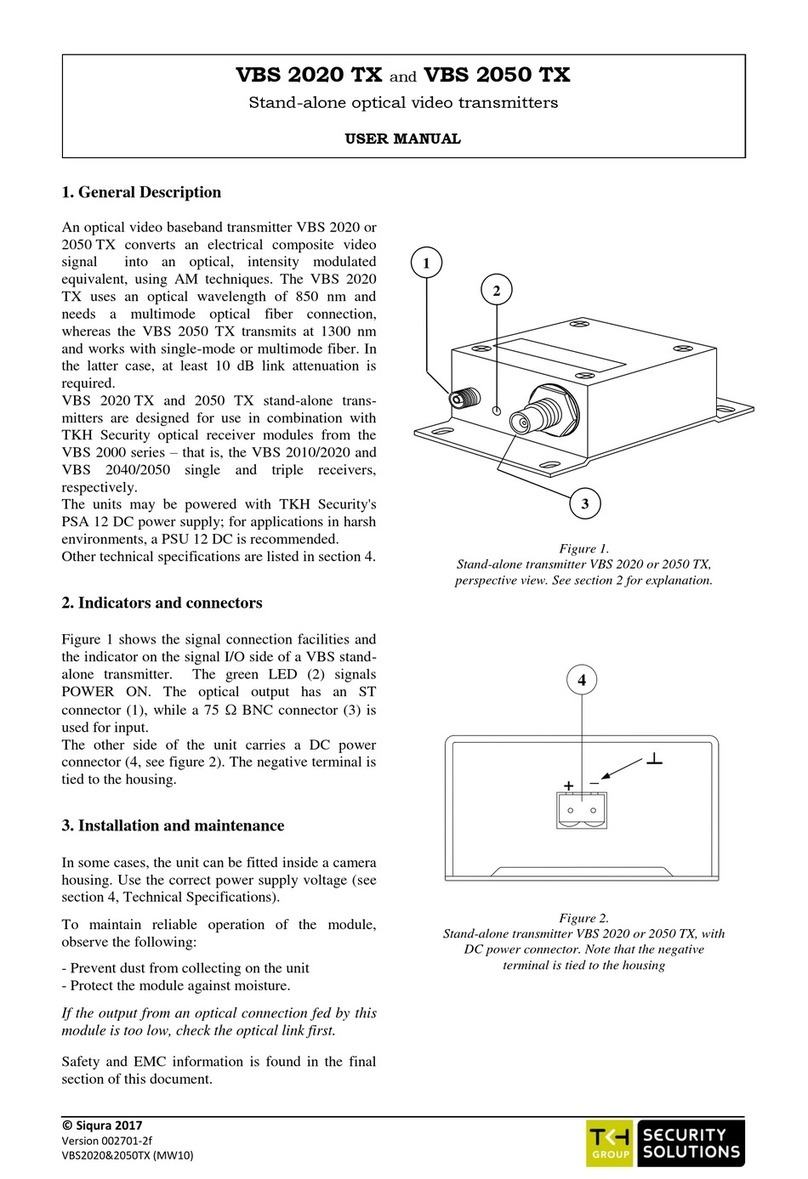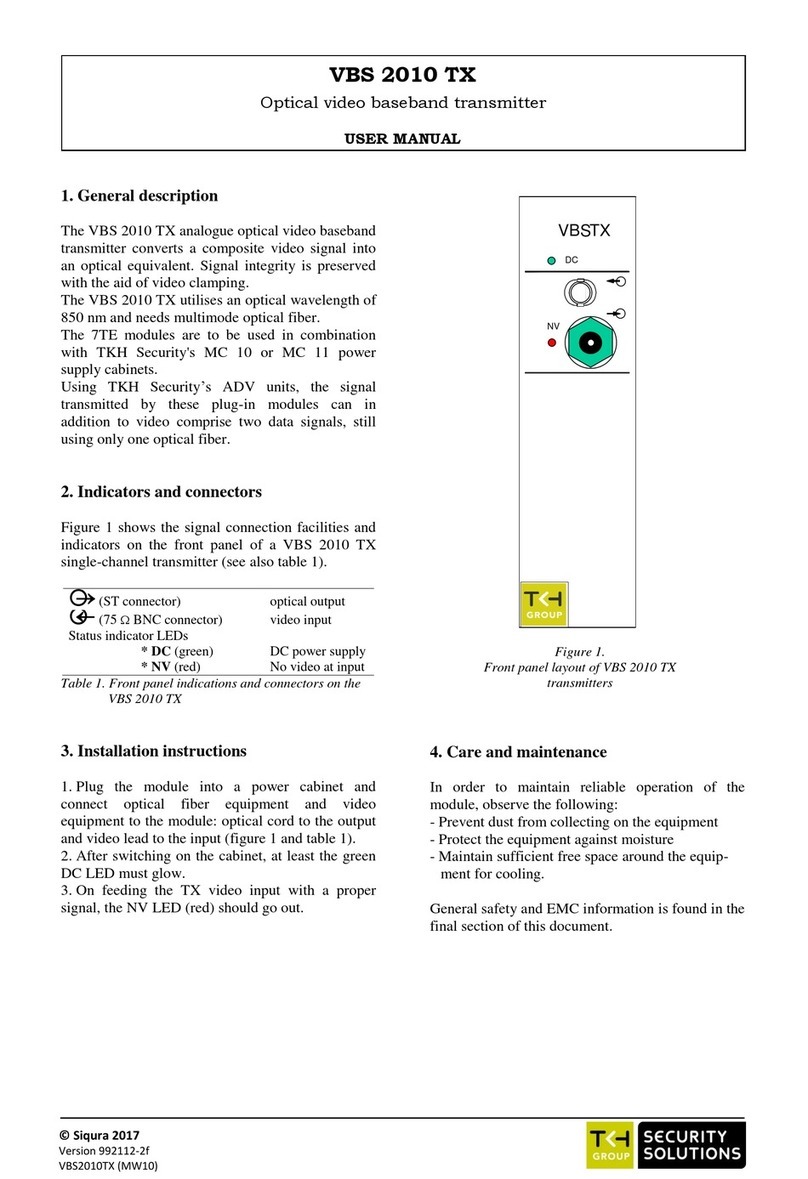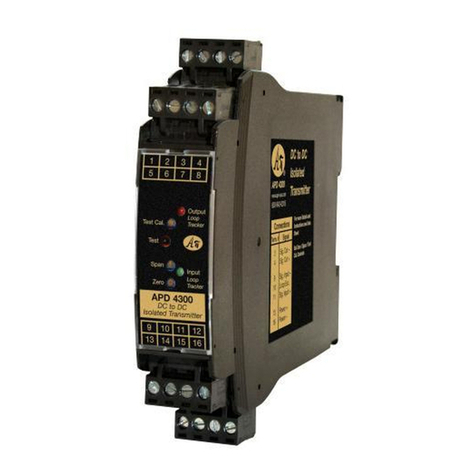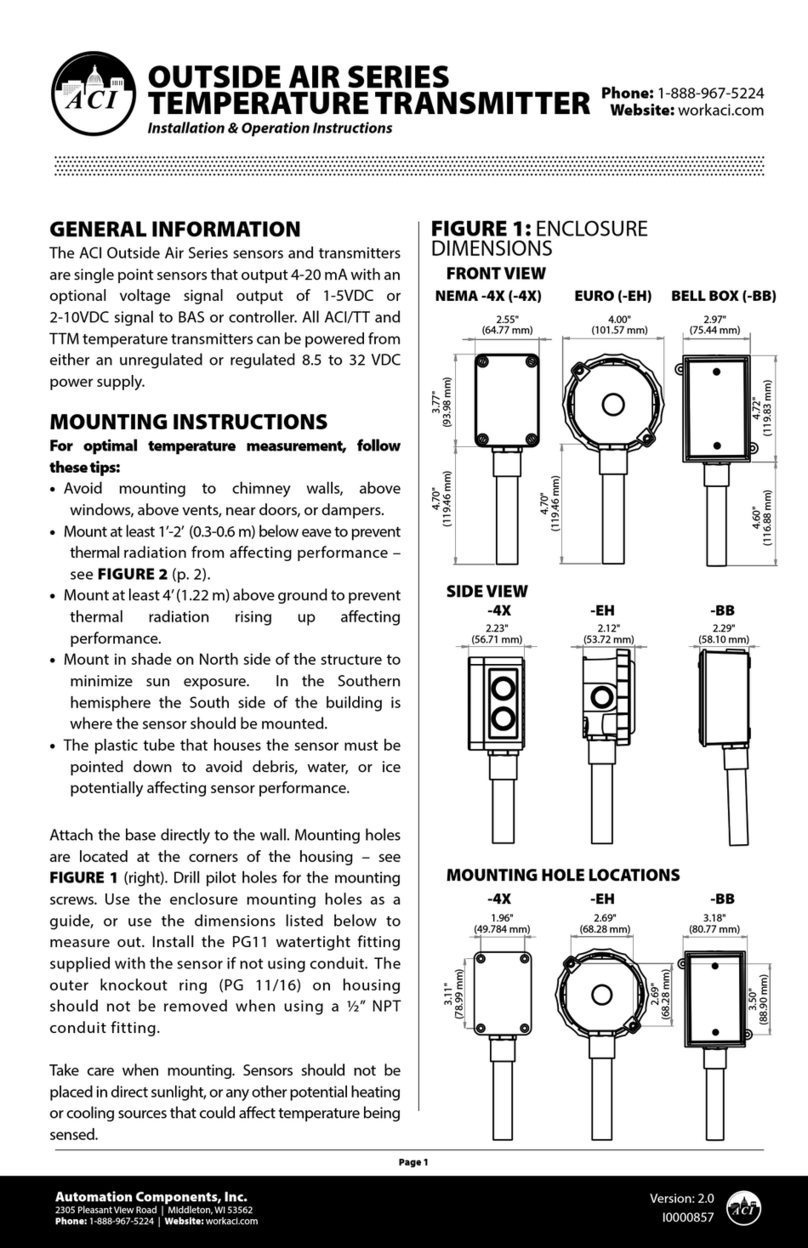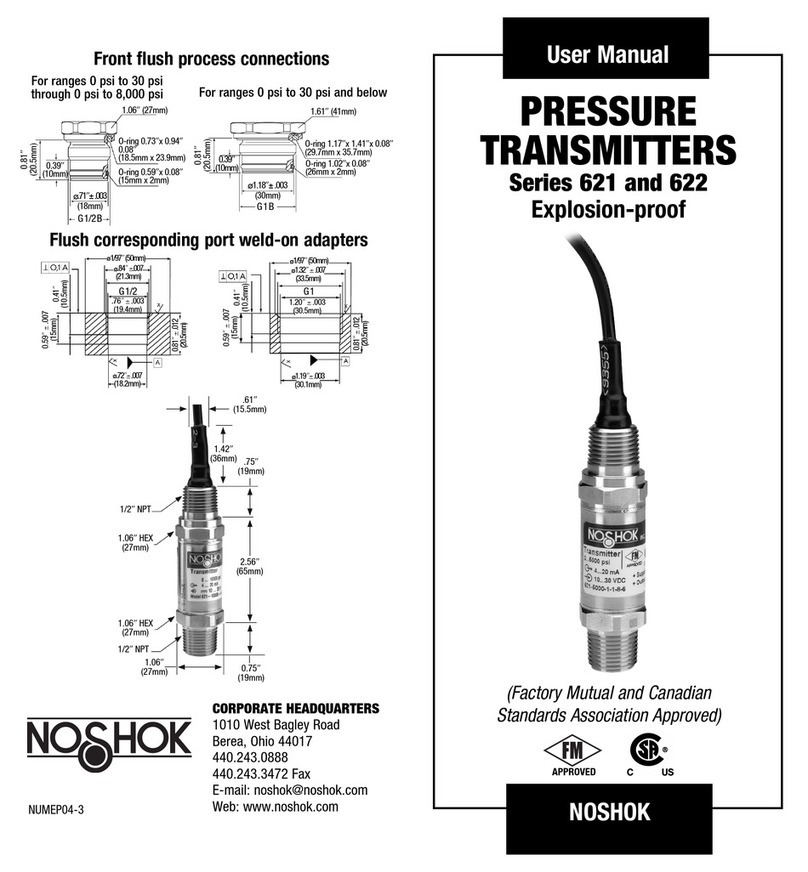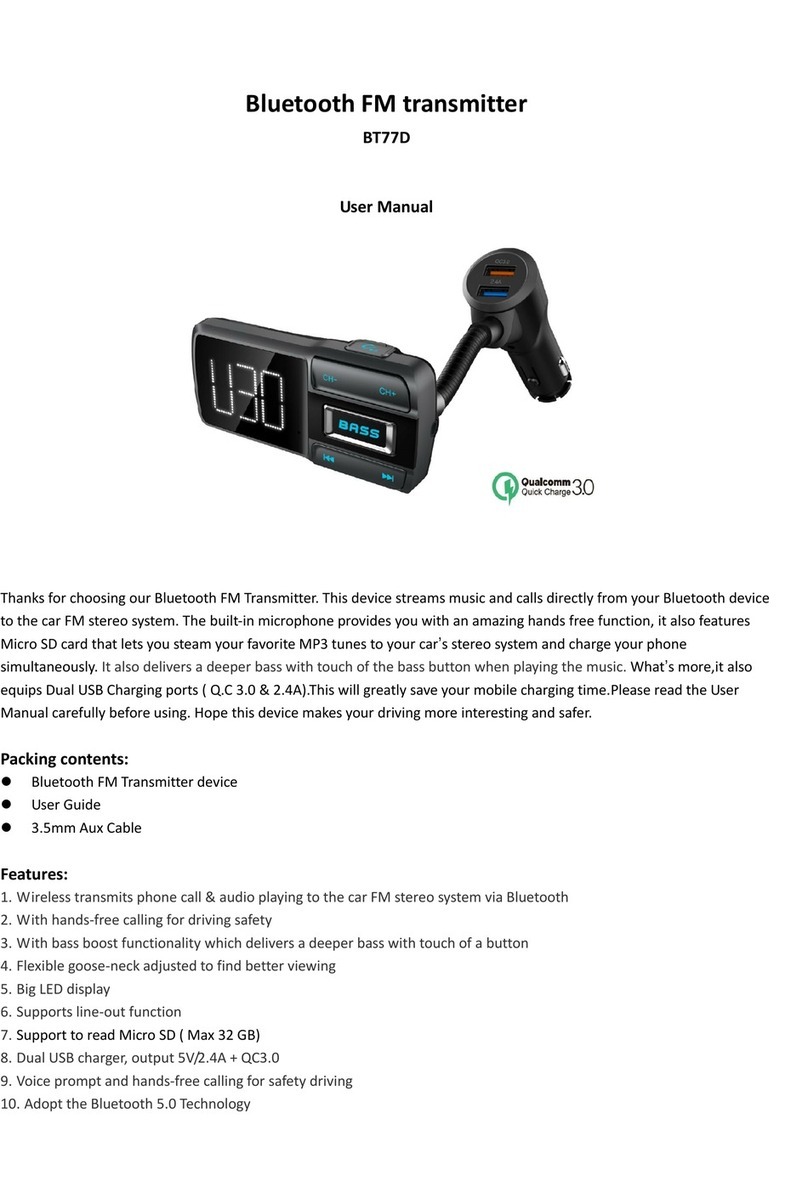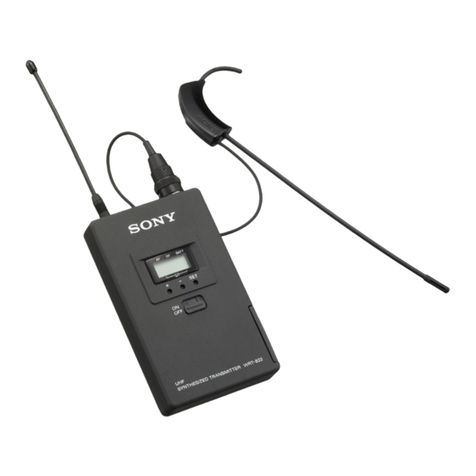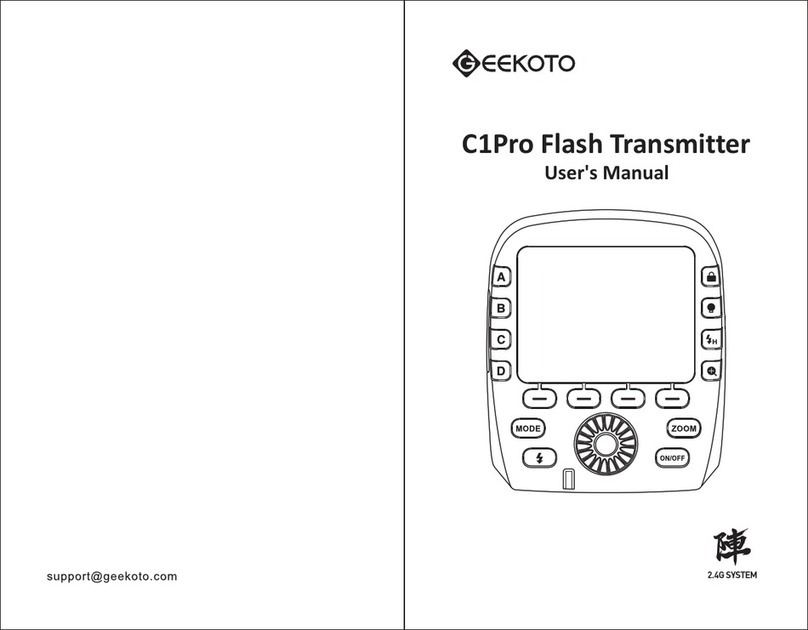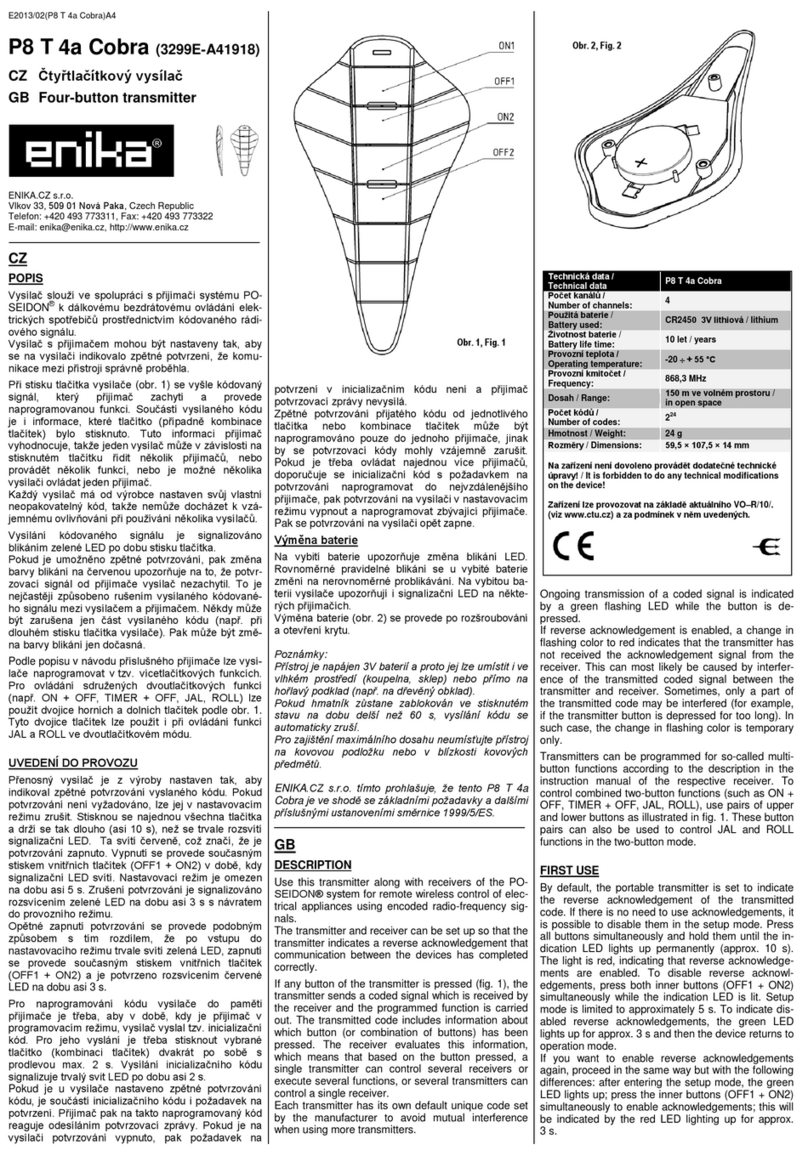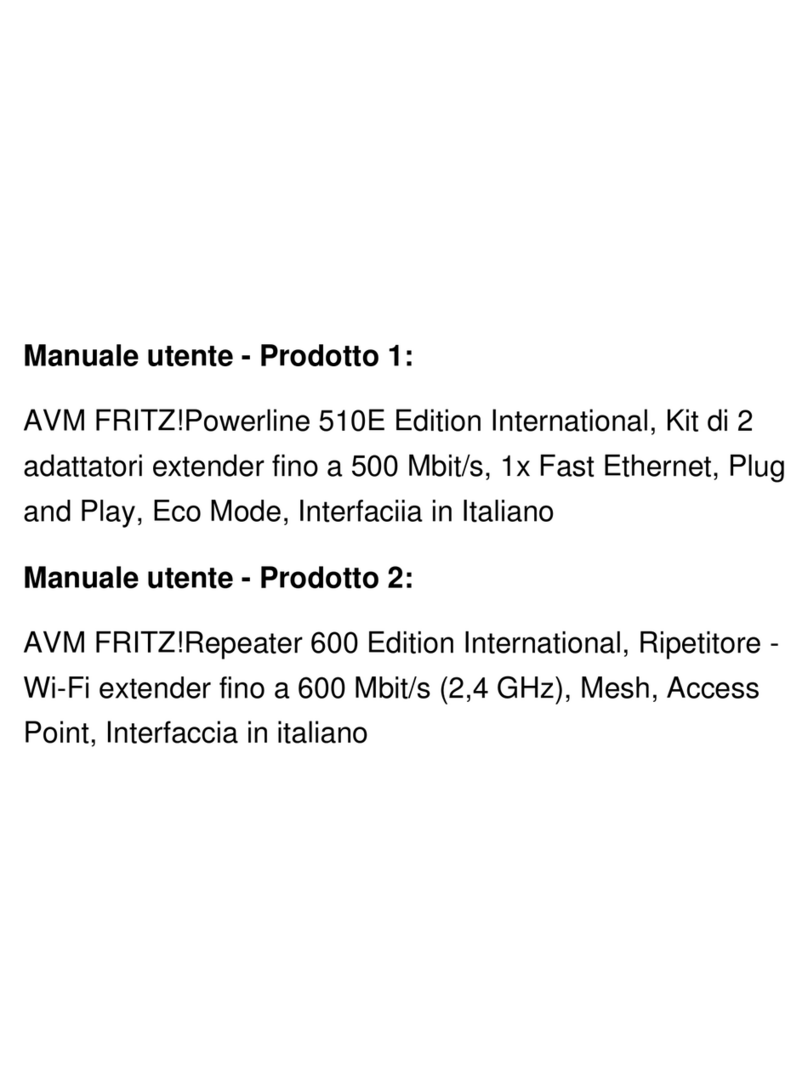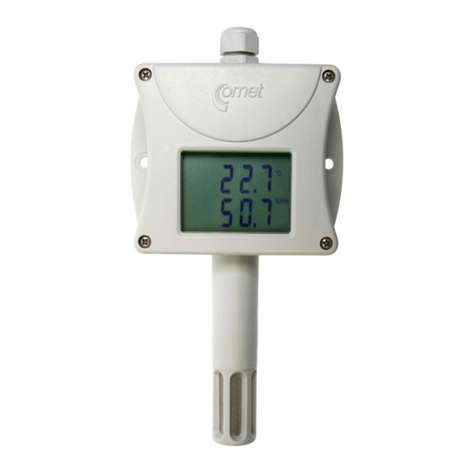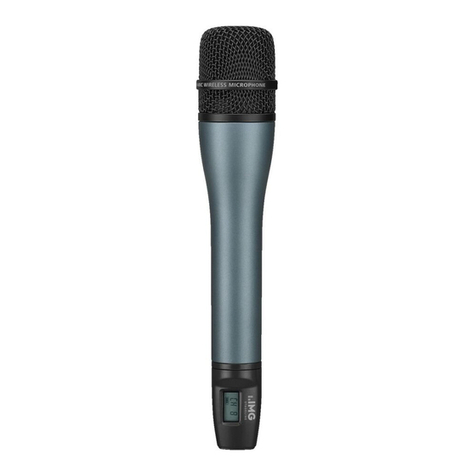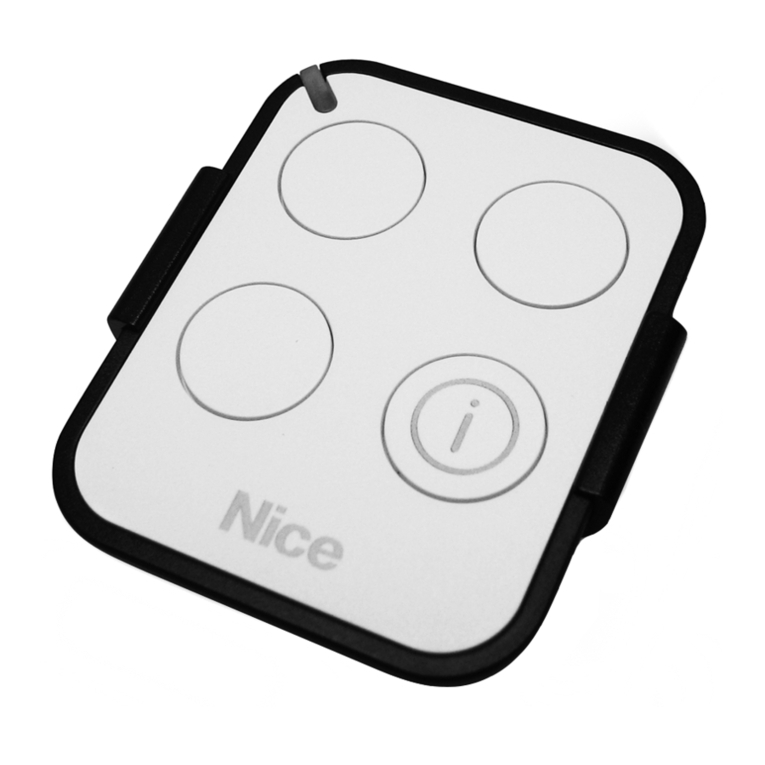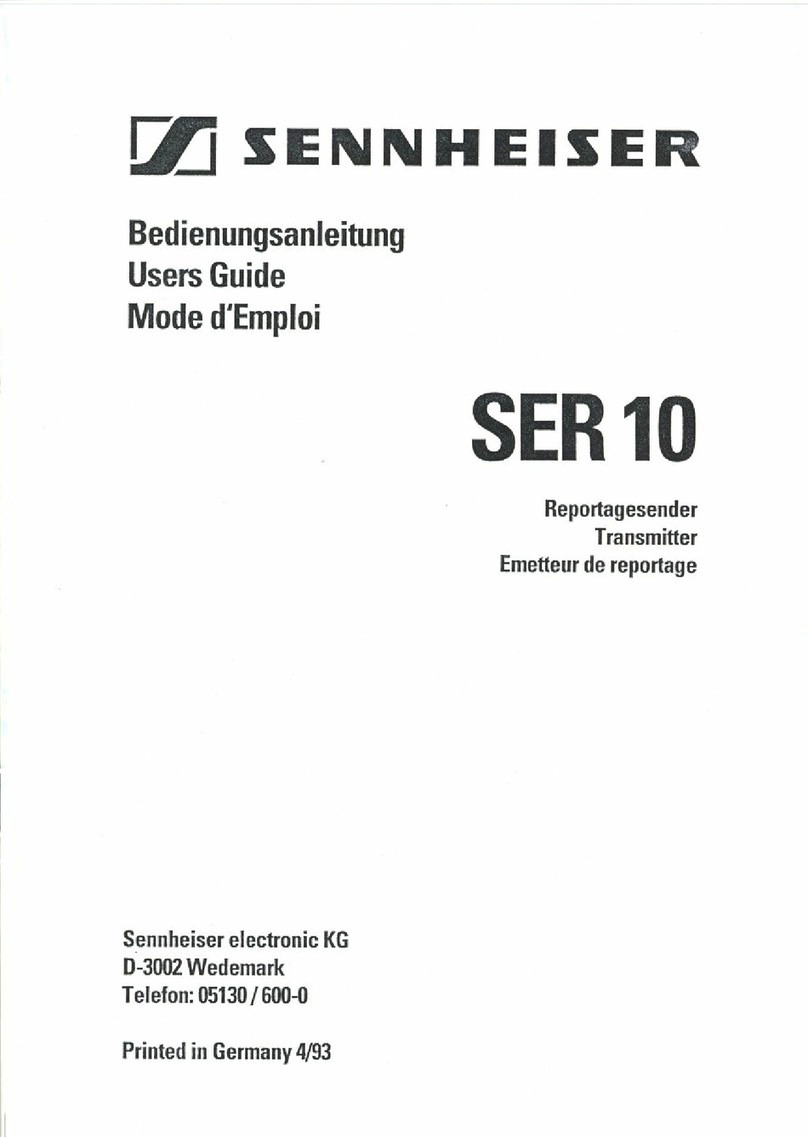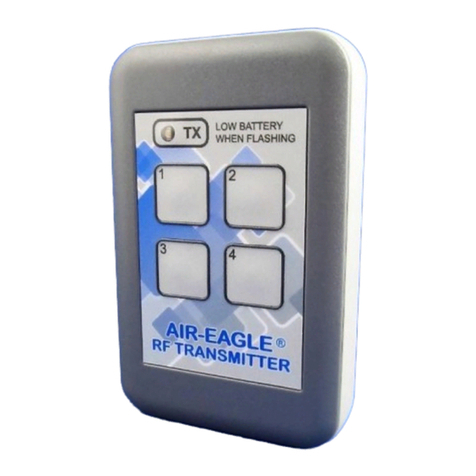TKH Optelecom 9000 Series User manual

Optelecom 9000 Series
Installation and Operation Manual
Model 9421DT
Model 9421DR
Rack-Mounted Fiber Optic Video Transmitter and
Receiver Cards
For transporting two NTSC or PAL, or SECAM video signals,
two duplex user-selectable Option Module port signals,
and a high-speed duplex RS422 data port signal over one
optical fiber. The video is encoded using a 9-bit
uncompressed digital technology combined with the data
and transmitted on the fiber digitally.
UM50319, Manual 9421D, Rev. D


3
Table of Contents
Section Page
Safety Instructions 4
Instrucciones de Seguridad 5
Sicherheitsanleitungen 6
Consignes de Sécurité 7
Fiber Information 8
External Wiring Information 8
Functional Description 9
9421DT Indicator and Connector Locations 10
9421DR Indicator and Connector Locations 12
Set Up and Operation of the 9421D 14
Typical Application of the 9421D 16
Operation of the 9421D with the Network Management System Software 16
Troubleshooting 9421D Links 17
Specifications for the Model 9421D 18

4
Safety Instructions
The optical devices used in this equipment are Hazard Level 1M. As required by IEC60825-1, the installer is responsible for insuring that the label
depicted below is present in the restricted locations where this equipment is installed.
This assembly contains parts sensitive to damage by electrostatic discharge (ESD). Use ESD precautionary procedures when touching,
removing, or inserting parts or assemblies.
The chassis into which this unit is installed must be housed in a properly rated NEMA enclosure.
When this unit is operated in extremely elevated temperature conditions, it is possible for internal and external metal surfaces to
become extremely hot. Care should be taken to insure this unit is installed in a restricted area where only properly trained service
personnel have access to the unit.
The safety information contained in this section, and on other pages of this manual, must be observed whenever this unit is operated,
serviced, or repaired. Failure to comply with any precaution, warning, or instruction noted in the manual is in violation of the standards of
design, manufacture, and intended use of the unit. TKH Security Solutions USA assumes no liability for the customer’s failure to comply
with any of these safety requirements.
RM-1
LASER RADIATION
DO NOT VIEW DIRECTLY WITH OPTICAL INSTRUMENTS (MAGNIFIERS)
CLASS 1M LASER PRODUCT
CAUTION:
DISCONNECTED OPTICAL CONNECTORS MAY EMIT OPTICAL ENERGY.
DO NOT VIEW BEAM WITH OPTICAL INSTRUMENTS (MAGNIFIERS)
This product contains Class 1M lasers or LEDs.
• Class 1M laser product according to IEC60825-1:1993+A1+A2
• CAUTION: Use of controls or adjustments or procedures other than those specified herein may result in hazardous radiation exposure.
• Precautions should be taken to prevent exposure to optical radiation when the unit is removed from its enclosure or when fiber is
disconnected from the unit.
•Laser radiation may be present on a fiber connection to this unit even when the power has been removed from the unit.
•This unit is intended for installation in locations where only trained service personnel have access to the fiber connections.
•The locations of all optical connections are listed in the Connection Locations and Function section of this manual.
•Optical outputs and wavelengths are listed in the Specifications section of this manual.
Hazard Level 1M
The border shall be black and
the background shall be yellow

5
Instrucciones de Seguridad
Los dispositivos ópticos usados en este equipo son de Nivel de Riesgo 1M. Según lo exige la norma IEC60825-1, el instalador es responsable de asegurar
que la etiqueta descrita a continuación esté presente en las áreas restringidas donde se instale este equipo.
Este ensamblaje contiene piezas sensibles al daño por descargas electrostáticas (ESD, por sus siglas en inglés). Use
procedimientos para prevenir las descargas electrostáticas al tocar, desmontar o insertar piezas o ensamblajes.
El chasis en el cual está instalada esta unidad debe estar dentro de un alojamiento debidamente calificado por NEMA.
Cuando se opera esta unidad en condiciones de temperatura sumamente elevada, es posible que las superficies internas y
externas de metal se pongan extremadamente calientes. Debe tenerse cuidado para asegurar que esta unidad se instale
en un área restringida donde sólo tenga acceso a la unidad el personal de servicio debidamente capacitado.
Debe observarse la información de seguridad contenida en esta sección, y en otras páginas de este manual siempre que se opere, dé
servicio o repare esta unidad. Si no se cumple con alguna precaución, advertencia o instrucción indicada en este manual se infringen los
estándares de diseño, fabricación y el uso destinado a la unidad. TKH Security Solutions USA no asume ninguna responsabilidad si el cliente
no cumple con alguno de estos reequisitos de seguridad.
RM-1
RADIACIÓN LÁSER
NO VER DIRECTAMENTE CON INSTRUMENTOS ÓPTICOS (DE AUMENTO)
PRODUCTO LÁSER CLASE 1M
PRECAUCIÓN:
LOS CONECTORES ÓPTICOS DESCONECTADOS PUEDEN AMITIR ENERGĺA ÓPTICA
NO VER EL HAZ CON INSTRUMENTOS ÓPTICOS (DE AUMENTO)
Este producto contiene rayos láser o diodos emisores de luz Clase 1M.
• Producto láser Clase 1M conforme a la norma IEC60825-1: 1993+A1+A2
•PRECAUCIÓN: El uso de los controles, ajustes o procedimientos, aparte de los aquí especificados, pueden ocasionar exposición peligrosa a la
radiación.
•Deben tomarse precauciones para evitar la exposición a la radiación óptica cuando se saque la unidad de su alojamiento, o cuando se
desconecte la fibra de la unidad
• Puede haber radiación laser en una conexión de fibra a esta unidad aun cuando se haya eliminado la corriente de la unidad.
•Este equipo está destinado a instalarse en lugares donde sólo el personal de servicio debidamente entrenado tenga acceso a las conexiones
de fibra.
•La ubicación de todas las conexiones ópticas se enumeran en la sección Ubicación de los conectores y funciones de este manual.
•Las salidas ópticas y longitudes de onda aparecen en la sección Especificaciones de este manual.
El bordo debe ser negro y
el fondo debe ser amarillo
Nivel de Riesgo 1M

6
Sicherheitsanleitungen
Die optischen Vorrichtungen in diesem Gerät haben Gefahrenstufe 1M. Wie vorgeschrieben durch IEC60825-1 ist der Installateur dafür verantwortlich,
sicherzustellen, dass die unten abgebildeten Schilder an den Orten mit eingeschränktem Zugang, an denen dieses Gerät aufgestellt ist, vorhanden sind.
Diese Baugruppe enthält Teile, die durch elektrostatische Entladungen (ESD) beschädigt werden können. Vorsichtsmaβnahmen
zum Schutz vor elektrostatischer Entladung treffen, wenn Teile oder Baugruppen berührt, ausgebaut oder eingefügt werden.
Das Gestell, in dem diese Einheit eingebaut ist, muss in einem entsprechend klassifizierten NEMA-Schutzgehäuse untergebracht
sein.
Wenn diese Einheit bei besonders hohen Temperaturen betrieben wird, können interne und externe Metallflächen extrem heiβ
werden. Es muss darauf geachtet werden, dass diese Einheit in einem Bereich mit eingeschränktem Zugang aufgestellt wird,
damit nur geschultes Wartungspersonal Zugang zur Einheit hat.
Die in diesem Abschnitt und auf anderen seiten dieses Handbuchs enthaltenen Sicherheitsinformationen müssen befolgt werden, wenn
diese Einheit betrieben, gewartet oder repariert wird. Falls Vorsichtsmassnahmen, Warnungen oder Anweisungen in diesem Handbuch
nicht befolgt werden, verstösst dies gegen die Konstruktions, und Herstellungsstandards und erfolgt im gegensatz zum vorgesehenen
Verwendungszweck dieser Einheit. TKH Security Solutions USA übernimmt keine Haftung für das Verabsäumnis des Kunden, diese
Sicherheitsanforderungen einzuhalten.
RM-1
LASER-STRAHLUNG
NICHT DIREKT MIT OPTISCHEN INSTRUMENTEN (LUPEN) ANSEHEN
LASER-PRODUKT DER KLASSE 1M
VORSICHT:
ABGEKLEMMTE OPTISCHE STECKVERBINDER KÖNNEN OPTISCHE ENERGIE FREI SETZEN
NICHT MIT OPTISCHEN INSTRUMENTEN (LUPEN) IN DEN STRAHL BLICKEN.
Dieses Produkt enthält Laser oder LEDs der Klasse 1M.
• Laserprodukt der Klasse 1M gemäß IEC60825-1:1993+a1+A2
• VORSICHT: Wenn die Bedienungselemente anders als hier beschrieben bzw. andere Einstellungen verwendet werden, kann es zu
schädlicher Strahlenaussetzung kommen.
•Es müssen Vorsichtsmaßnahmen getroffen werden, um Aussetzung an optischer Strahlung zu vermeiden, wenn die Einheit aus dem Gehäuse
genommen oder die Faseroptik von der Einheit getrennt wird.
• In einer Faseroptik-Verbindung dieser Einheit kan auch dann Laserstrahlung vorhanden sein, wenn die Stromversorgung zur Einheit
abgeschaltet wurde.
•Diese Einheit ist zum Einbau an Orten vorgesehen, an denen nur geschultes Personal Zugang zu den Faseroptik-Verbindungen hat.
•Die Lage aller optischen Verbindungen ist im Abschnitt über die Lage von Anschlüssen und Funktionsweise dieses Handbuchs zu finden.
•Optsiche Ausgänge und Wellenlängen sind im Abschnitt mit den technischen Daten dieses Handbuchs zu finden.
Gefahrenstufe 1M
Schwarzer Rand und
gelber Hintergrund

7
Consignes de Sécurité
Les appareils optiques utilisés dans cet équipement correspondent à un niveau de danger 1M. Comme exigé par la norme IEC60825-1, il incombe à
l’installateur de s’assurer que l’étiquette ci-dessous est présente aux endroits d’accès limité où cet équipement est installé.
Cet ensemble contient des pièces sensibles aux décharges électrostatiques (ESD). Prendre les précautions relatives aux ESD avant
de toucher, retirer ou insérer des pièces ou des ensembles.
Le châssis dans lequel est installé cet appareil doit être place dans une enceinte NEMA conforme aux spécifications nominales.
Lorsque cet appareil fonctionne à une température ambiante extrêmement élevée, il est possible que les surfaces métalliques
internes et externes deviennent extrêmement chaudes. S’assurer que cet appareil est installé dans une zone dont l’accès est
limité à un personnel de maintenance correctement formé.
Les consignes de sécurité contenues dans cette section et dans le reste de ce manuel doivent être respectées a chaque fois que cet appareil
est utilisé ou fait l’objêt d’une maintenance ou d’une réparation. Le non-respect d’une précaution, d’un avertissement ou d’une instruction
figurant dans ce manuel est une violation des normes de conception, fabrication et indication d’usage de l’appareil. TKH Security Solutions
USA n’est pas responsable du non-respect de ces consignes de sécurité par le client.
RM-1
RAYONNEMENT LASER
NE PAS REGARDER DIRECTEMENT AVEC DES INSTRUMENTS OPTIQUES (LOUPES)
PRODUIT LASER DE CLASSE 1M
ATTENTION:
LES CONNECTEURS OPTIQUES DEBRANCHES PEUVENT EMETTRE UNE ENERGIE OPTIQUE.
NE PAS REGARDER LE FAISCEAU AVEC DES INSTRUMENTS OPTIQUES (LOUPES)
Ce produit contient des lasers ou diodes électroluminescentes de classe 1M.
• Produit laser de classe 1M conformément à IEC60825-1:1993+A1+A2
• ATTENTION: L’ utilisation de commandes ou réglages, ou de procedures différentes de celles indiquées ici risque de provoquer une
exposition dangereuse au rayonnement.
• Prendre des précautions pour empêcher une exposition au rayonnement optique lorsque l’ appareil est retiré de son boîtier ou lorsque la
câble optique fibre est débranché de l’ appareil.
•Un rayonnement laser pourra être present dans un câble optique branché sur cet appareil, même une fois l’alimentation coupée.
•Cet appareil est prévu pour une installation à des endroits où seul un personnel de maintenance formé accès aux câbles optiques.
•Les points de branchement de tous les cables optiques sont indiqués à la section Points de branchement et function de ce manuel.
•Les sorties et longueurs d’ onde optiques figurant à la section Caractéristiques techniques de ce manual.
Niveau de danger 1M
La bordure doit être noire et
le fond jaune

8
Fiber Information
This unit was manufactured with attention to fiber cleanliness by TKH Security Solutions USA. Beyond the optical
safety information contained in this manual, the following guidelines should be observed when working with
optical fibers.
The biggest problem is dirt!
It takes very little contamination to cause problems with optical fiber connections; cleanliness is extremely
important to proper operation of optical equipment.
1. Protect optical connectors by leaving the connector covers in place on unused fiber connections and on the
fiber tips themselves.
2. Personnel who remove and replace fibers should be equipped with a fiber cleaning kit. These are inexpensive
and can be obtained from any fiber equipment supply house. If you choose to, you can use propanol and lint-
free tissue to clean fibers.
a. Do not use isopropanol alcohol (typically called rubbing alcohol) mixed with water. This can cause
additional spots. (Caution:
Pure isopropanol is very flammable!
)
b. Use lintless tissues to clean fibers.
c. Clean the fiber with a folded tissue moistened with the propanol, pulling the connector tip across the
tissue, then turn the connector 90 degrees and repeat in a different spot on the tissue.
d. Don’t pull the fiber across and then push it back. This will put the dirt that was cleaned off back on
again.
e. Repeat the process on a dry, folded tissue.
3. When removing fibers,
always
clean them when replacing them no matter how long you had them off.
4. When connecting fibers, pay attention to the bend radius of the fibers. A general rule is to have a 3-inch
(8 cm) bend radius. A bend radius less than 3 inches is an attenuator and can cause optical signal loss.
5. Installers of fiber equipment should be equipped with the equipment manuals and an optical power meter to
measure the optical inputs and outputs in a system. An optical power meter is an inexpensive tool that can
save much time and effort in getting optical communications links up and running. Properly equipped and
trained installers can quickly determine the source of any problems that occur.
External Wiring Information
Cable assemblies with lengths external to the unit not exceeding 3.05 meters, coiled or uncoiled, may be
constructed of jacketed appliance wiring material suitable for the maximum voltage current and temperature,
rated VW-1 or FT-1 or better. Cable assemblies with lengths external to the unit not exceeding 3.05 meters, coiled
or uncoiled, and supplied by a limited power source or NEC Class 2 source of supply as defined in the National
Electric Code, ANSI/NFPA 70, may be constructed of materials rated VW-1 or FT-1 or better with no additional
requirements.

9
Functional Description
The 9421DT transmitter accepts two composite video signals in NTSC, PAL, or SECAM format via two BNC video
input ports. The baseband video signals are each sampled at a 16 Mhz rate by an A-to-D converter operating with
nine bits of precision. The signals are multiplexed, serialized along with the serial data from the option modules
and the high-speed port, and converted to an optical signal for transmission over the fiber. For the reverse
direction, data comes into the transmitter via an optical receiver operating at a different wavelength than the
transmitter. The received data stream is demultiplexed into data for output via the Option Modules and high-speed
port.
The 9421DR receiver accepts the optical signal and demultiplexes it into bit streams for the video and the data.
The video stream signal is deserialized and converted back into the video signals, which are output at the BNC
connectors. The data stream is demultiplexed and sent to the Option Modules and high-speed Port. For the
reverse direction, outputs from the Option modules and high-speed Port are multiplexed together and converted to
an optical signal for transmission to the transmitter on the second wavelength.
The 9421DT and DR support two TKH Security USA Data/Audio Option Modules. The modules operate
bidirectionally. The user may select from duplex audio (Option Module type A), duplex data (Option Module type
B), duplex contact closure (Option Module type C) or Stereo Audio (Option Module type D, Stereo Input, and E,
Stereo Output).
The Xs in the 9421DT(XX)-Y-ZZ and 9421DR(XX)-Y-ZZ model numbers should be replaced with the letter for the
type of Option Module desired. The specific Option Modules installed are indicated by labels on the front panel
and on the AUX I/O connectors.
The high-speed port operates in both directions. It provides a simplex 16 MB synchronous or 1.6 MB
asynchronous RS422 port. This port is designed to operate with the 9961-C or 9962-C Option Module Host
cards or the 9971-C high-speed port to 10 Base T Ethernet card. The 9961-C and 9962-C cards add data,
audio, and contact closure channels. The 9971-C card has two user-programmable serial data ports and one
Full or Half Duplex 10 Base T Ethernet Link.
9421DT and DR cards are optically compatible with the 9425DT and 9425DR stand-alone models.
The cards operate on 6VDC as supplied by the chassis into which it is installed.

10
9421DT Indicator and Connector Locations
FIGURE 1
1. SYNC INDICATOR
This multicolor LED provides status information about the link as follows:
OFF
indicates no power is applied to the card.
Red
(No Sync) indicates the local unit is not receiving sufficient optical signal from the remote unit or the local
demux circuitry is not able to synchronize to the incoming signal.
Yellow
(Sync, No Loop) indicates that the local unit is synchronized to the remote unit, but the remote unit is
reporting it has not synchronized to the local unit.
Green
(Sync, Loop, Normal Operation) indicates that the local unit has synchronized to the signal from the
remote unit and the remote unit is reporting it has synchronized to the local unit.
2. OPTICAL CONNECTOR
The optical connection is made here.
3. CHANNEL 1 AND CHANNEL 2 VIDEO INPUT CONNECTORS
These BNC connectors are the inputs for the video signals.
4. CHANNEL 1 AND CHANNEL 2 VIDEO PRESENT INDICATORS
Each of these indicators will illuminate
green
when a video signal is present on its respective Video Input connector.

11
5. AUX I/O 1 CONNECTOR
This is the connector for Option Module position 1. Refer to the separate Option Module Manual included with your
shipment for details on connections to the Option Modules.
6. AUX I/O 2 CONNECTOR
This is the connector for Option Module position 2. Refer to the separate Option Module Manual included with your
shipment for details on connections to the Option Modules.
7. HIGH-SPEED PORT CONNECTOR
This RJ45 connector provides the clock and data connections for the high-speed port.

12
9421DR Indicator and Connector Locations
FIGURE 2
1. SYNC INDICATOR
This multicolor LED provides status information about the link as follows:
OFF
indicates no power is applied to the card.
Red
(No Sync) indicates the local unit is not receiving sufficient optical signal from the remote unit or the local
demux circuitry is not able to synchronize to the incoming signal.
Yellow
(Sync, No Loop) indicates that the local unit is synchronized to the remote unit, but the remote unit is
reporting it has not synchronized to the local unit.
Green
(Sync, Loop, Normal Operation) indicates that the local unit has synchronized to the signal from the
remote unit and the remote unit is reporting it has synchronized to the local unit.
2. OPTICAL CONNECTOR
The optical connection is made here.
3. CHANNEL 1 AND CHANNEL 2 VIDEO OUTPUT CONNECTORS
These BNC connectors are the outputs for the video signals.
4. CHANNEL 1 AND CHANNEL 2 Tx VIDEO PRESENT INDICATORS
Each of these indicators will illuminate
green
when a video signal is present on the
transmitter
Video Input
connector.

13
5. AUX I/O 1 CONNECTOR
This is the connector for Option Module position 1. Refer to the separate Option Module Manual included with your
shipment for details on connections to the Option Modules.
6. AUX I/O 2 CONNECTOR
This is the connector for Option Module position 2. Refer to the separate Option Module Manual included with your
shipment for details on connections to the Option Modules.
7. HIGH-SPEED PORT CONNECTOR
This RJ45 connector provides the clock and data connections for the high-speed port.

14
Set Up and Operation of the 9421D
Set up and operation of the 9241DT and units consists of:
Set the switches on the Option Modules. Refer to the Option Module manual for details on the switches and
connections for each module type.
Install the card into a Series 9000 chassis.
Make the required audio, data, or contact closure cables to the Option Module connectors and plug the
connectors into the Aux Ports on the front panel.
Connect the high-speed port.
Connect the video input and output signals.
Connect the fiber.
AUX PORTS 1AND 2OPERATION
Aux Ports 1 and 2 are supported by TKH Security USA Option Modules. These may be duplex audio, data, contact
closure, or stereo audio depending on how the cards were ordered from the factory. The user can exchange
Option Module types as required, contact your local TKH Security USA representative or the factory for details on
changing Option Module types. Please refer to the Option Module manual for instructions on setting and
connecting the modules.
HIGH SPEED PORT OPERATION
The high-speed port is a 16 Mbps simplex synchronous RS422 port. The port may be used synchronously at a
speed of 16 MB and asynchronously at up to 1.6 Mbps. It may be used as an RS422 port or to interface directly
with the 9961-C or 9962-C Option Module Host Cards.
The 9961-C and 9962-C provide any combination of four or eight duplex audio, data, contact closure, or stereo
audio channels. This is in addition to the video and the two Option Module channels already built into the 9401DT
and DR cards.
The 9971-C High-Speed Port to 10 Base T Ethernet Card provides two duplex serial ports and one 10 Base T
Ethernet Link via the high-speed port.
The ports are wired as shown in Figure 3 and in Table 1. The 9961-C, 9962-C, and 9971-C cards are normally
supplied with a properly configured cable for connection to the high-speed port. A standard (not crossover) RJ45
CAT5 cable will also work correctly.

15
FIGURE 3
TABLE 1 —9421DT AND DR
HIGH-SPEED PORT CONNECTIONS
RJ45 Pin #
Signal Name
1
Tx Data (+) Input
2
Tx Data (–) Input
3
Tx Clock (+) Output
4
Rx Data (+) Output
5
Rx Data (–) Output
6
Tx Clock (–) Output
7
Rx Clock (+) Output
8
Rx Clock (–) Output

16
Typical Application of the 9421D
Operation of the 9421D with the Network Management System
Software
Operation of the 9421D with the Network Management System consists of the following parameters:
1. Card Location
2. Card Size
3. Card Name (Model Number)
4. Serial Number
5. Revision Number
6. Chronometer Value (Cumulative Hours of Operation)
7. Reset Cycles (Cumulative Number of Power Cycles)
8. Firmware Revision
9. Channel 1 Video Present on Input BNC (Transmitter only)
10. Channel 2 Video Present on Input BNC (Transmitter only)
11. Channel 1 Video Present on Input BNC at Transmitter (Receiver only)
12. Channel 2 Video Present on Input BNC at Transmitter (Receiver only)
13. Local Demultiplexer in Sync (Sync)
14. Remote Demultiplexer in Sync (Remote Sync)
15. Output LED/Laser Current (Transmitter only)

17
Troubleshooting 9421D Links
The indicator LEDs on the transmitter and receiver provide information as to the optical and electrical status of
the units. Troubleshooting normally starts at the transmitting end.
On the 9421DT and 9421DR cards, the sync indicator should be illuminated with one of three colors. If it is not
illuminated, check the chassis power supply, power source, and connections.
When the SYNC indicator is illuminated
green
,operation is normal. When the SYNC is illuminated
red
, this is
usually an indication of insufficient optical signal at the optical input. Check the fiber for poor connections or
optical losses greater than the unit specifications.
If the SYNC indicator is
yellow
, the local unit is in sync and the remote unit is not. This usually means that there
is an optical loss problem in one direction from the local unit to the remote. Again, check the fiber for bends or
check the optical link for excessive losses.
Since this unit uses two wavelengths, the losses for each one can be different. Each wavelength reacts
differently to bends and splices as well.
When video is connected to Channel 1 or Channel 2 input BNCs, the Video Present indicator for that channel
should be illuminated green. If the Video Present indicator is not green, then check the video source and
connections.
IF both STATUS indicators are illuminated
green
and the TX Video Present indicator is not illuminated, the video
source at the
transmitter
end should be checked.

18
Specifications for the Model 9421D
OPTICAL SPECIFICATIONS
Model
MM
MM
SM
Fiber Size
50/125
62.5/125
09/125
Tx Optical Output Power (dBm)
–11
–7
–7
Tx Output Wavelength
1310
1310
1310
Rx Receiver Sensitivity (dB)
–29
–29
–25
Tx Budget (dB)
18
22
18
Rx Optical Output Power (dBm)
–11
–7
–7
Rx Output Wavelength
850
850
1550
Tx Receiver Sensitivity (dB)
–31
–31
–31
Rx Link Budget (dB)
20
24
24
Estimated Distance (Km)¹
4.5
3.52
42
1Ranges based on 3.0 dB/km @ 850 nm or 1.0 dB/km @ 1310 nm for 62.5/125 fiber and 0.35 db/Km loss on 09/125 fiber at 1310 nm or 0.25 dB/Km loss on 09/125 fiber at 1550 nm.
2Range may be limited by fiber quality and bandwidth.
VIDEO SPECIFICATIONS
Video Sampling Rate/Resolution 16.0 Mhz, 9-bit
Video Input/Output Signal NTSC, PAL, or SECAM, 1V p-p, 75Ω
Video Input/Output Connector BNC
Video Bandwidth 6.5 Mhz (-3.0 dB)
SNR ≥63 dB
Differential Phase ≤1°
Differential Gain ≤2%
DATA TRANSMISSION BY PORT
Connector RJ45
Data Format Synchronous RS422 @ 16 Mbps
Asynchronous RS422 @ 1.6 Mbps
POWER REQUIREMENTS
Voltage 6VDC supplied from chassis
Current, 9421DT 600 mA
Current, 9421DR 800 mA
PHYSICAL

19
Dimensions (in inches) 6.1 H x 0.8 W x 8.6 D
ENVIRONMENTAL
Operating Temperature -40° C to +74° C
Storage Temperature -55° C to +85° C
Relative Humidity 0 to 95% noncondensing
MECHANICAL MOUNTING AND CONNECTIONS DIMENSIONS

TKH Security Solutions
www.tkhsecurity.com
Siqura B.V.
Zuidelijk Halfrond 4 • 2801 DD Gouda
The Netherlands
Telephone: +31 182 592 333
Fax: +31 182 592 123
E-mail: sales.nl@tkhsecurity.com
TKH Security Solutions USA
12920 Cloverleaf Center Drive • Germantown
Maryland 20874 USA
Telephone: +1 301 444 2200
Toll Free: +1 800 293 4237
Fax: +1 301 444 2299
E-mail: sales.us@tkhsecurity.com
Other manuals for Optelecom 9000 Series
2
This manual suits for next models
2
Table of contents
Other TKH Transmitter manuals
